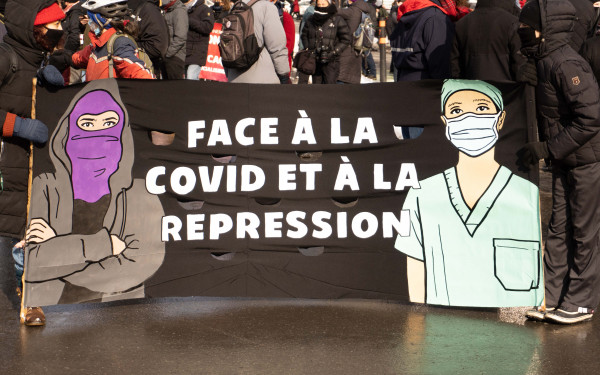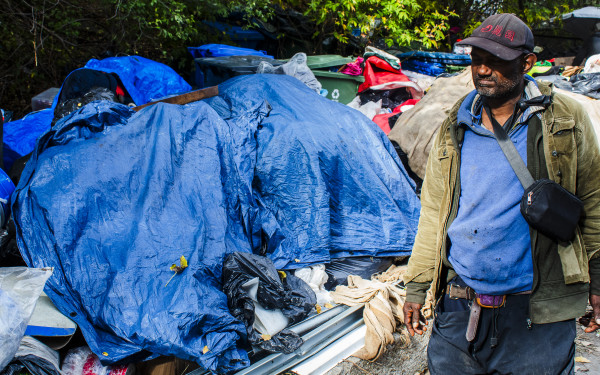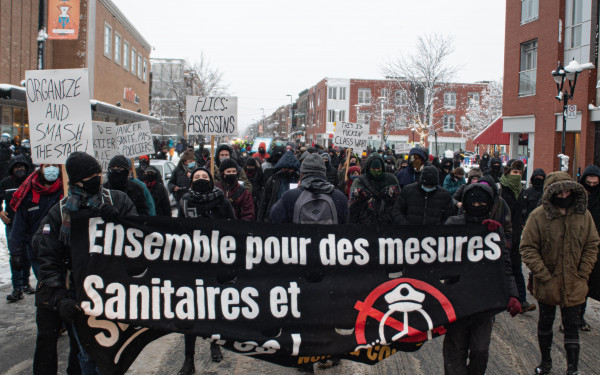Integration over extraction; prioritizing action
Comm-Un’s panel invites the community to share ideas on the role of academia in addressing homelessness
On Nov. 25, from 5 p.m. to 8 p.m., community members and students gathered at Concordia University's SHIFT center to learn about the non-profit Comm-Un, and discuss the role of universities in addressing homelessness.
Founded just over a year ago, Comm-Un is a non-profit collective deeply rooted in the Milton-Parc community, an area of Montreal made up of a number of unhoused Indigenous and Inuit persons.
In 2018, Indigenous people represented 12 per cent of Montreal's unhoused population, despite representing just under one per cent of the city's total population. Inuit made up 25 per cent of unhoused Indigenous people, despite making up only five per cent of Montreal’s Indigenous population.
Comm-Un’s panel addressed and critiqued the multiple social-worker and research programs throughout Montreal universities, highlighting what is missing in the exploration and intervention of homelessness.
Comm-Un believes the most important part about working with the unhoused is healing trauma.
According to Jonathan Lebire, founder and director of Comm-Un, the different approaches to homelessness—like “housing-first,” a concept that is recovery-focused which prioritizes swiftly placing individuals experiencing homelessness into stable housing, followed by further support and services that are offered based on individual needs—isn’t effective. Comm-Un, however, approaches care for the unhoused differently; to make healing and love the first step with unhoused communities. “I coach, I listen, but I don’t tell them what to do. They tell me what they need to do and I make sure they can do it,” Lebire told The Link.
“Unhoused people experience lots of trauma—most of the services now are focused on just survival needs, and we need some spaces that consider the healing process,” said Concordia PhD student Moh Abdalreza. Abdalreza helps organize, plan events and projects, and so much more, according to Lebire, who has dubbed the Concordia student “Super-Moh.” Abdalreza researches the relationship between art and homelessness.
A frequent sentiment expressed by Comm-Un is that there is a lack of communication between government bodies, neighbours, media and (most importantly) the unhoused regarding efforts to create safe spaces and take steps towards healing for a vulnerable population.
“We found that there is a big gap between lived experiences of unhoused people and policy making processes,” Abdalreza said.
Comm-Un also launched their current project and proposal for the collective at the panel. Their project, “Street University,” is described to be a strength-based space, alternative to day-shelters.
“[Street University] is about moving from fragmentation to reintegration, from survival needs to healing, and also merging resources,” Abdalreza noted.
Abdalreza stressed how universities have access to many resources. He shared how they own large amounts of land, infrastructure, and public spaces that have a copious potential to be employed for the benefit of the community. He feels many students who study homelessness within the walls of an institution fail to have actual conversations with their subjects; unhoused people.
When it came time for the panel, rectangular tables with three chairs were dually positioned in front of the panelists. Tables were set with crayons, markers, and paint-sticks coupled with paper to encourage art during the discussion.
The night, which drew in an audience of all ages, began with Lebire introducing himself and Comm-Un. He shared how, when he was about 16, he was unhoused.
Lebire left his home for Sherbrooke, Que., with $20 and a backpack. When he came back to Montreal, he wanted to make a change. He went to the Université de Montréal to become a social worker. However, school didn’t help him understand the complexity of being a social worker and working with unhoused populations.
“By the magic in life, I was introduced to the Indigenous people at Atwater park,” said Lebire. This changed how he saw intervention work.
The floor was then turned to the five panelists and researchers whose work aligned with addressing homelessness; Jayne Malenfant, Shayana Narcisse, Carmela Cucuzzella, Janis Timm-Bottos and Chris Brown.
When the question was posed to panelists about the universities’ impact on addressing homelessness, Malenfant expressed dissatisfaction with the disconnect from university researchers and those being researched.
Malenfant, an assistant professor in social justice and community engaged studies at McGill University, spent a period of her life unhoused.
“I often ask, ‘what is the point of working with researchers, and what is the point of working with universities when we as (unhoused) communities can take care of ourselves?’” she said. “The way we evaluate impact in the university is not just. It is not grounded in community knowledge, and there aren’t ongoing mechanisms for evaluation that are led by people who are directly impacted by the issues we are studying. The accountability isn't there,” Malenfant explained.
She believes one way universities could improve with its research approach, particularly when tackling homelessness, is by resourcing people with lived experiences and allowing them to lead the research.
For Timm-Bottos, the founder of Montreal’s first art-hive, social infrastructure within universities is the catalyst for action and change.
“We need to have gathering places, otherwise people are afraid of each other,” said Timm-Bottos. “We need to have these safe environments where we can throw off our identities and be real with each other.” She elaborated on how art is a method to communicate and learn from those residing in different socio-economic classes.
Comm-Un’s art hive is a testimony to Timm-Bottos’ shared sentiment. Members of the community paint, draw, carve stone or create any craft desired. Once the crafts are made, Lebire will
sell the creations —sometimes for upwards of $200— and relay the money back to the artist. According to Abdalreza, there is a type of communication that transcends beyond words when those of different power dynamics gather to create art and learn techniques from each other.
Lebire borrowed the mic from panelists for a moment to heed caution of the delicacy that should come with conducting research of the unhoused.
He described how, if you’re considered unhoused by the system, it’s primarily because you went through struggles which transformed into traumas that were not dealt with—as there was no safety net in place. Lebire explained how these traumas want to be forgotten.
“The worst thing for [an unhoused individual] is somebody poking you, and reminding you of all of these [traumas],” asserted Lebire. “Whenever all of these researchers ask those questions, you have to keep in mind, you are bringing those things back up for a person that still does not have any means to deal with it. So every time, you trigger [their trauma] without giving a healing opportunity.”
Narcisse is a creative with a focus on visual art and works toward action with her art. She has a lived experience with homelessness, and believes researchers with the subject of homelessness should approach the research in a holistic way: hiring the street workers and compensating them for the time spent learning from their experiences.
The panel later made room to hear and inquire further on the audience's ideas on where they think the role of universities fit in addressing homelessness.
One participant expressed suspicion in whether an institution can have an acceptable role in helping the unhoused community.
“Unless we radically transform what a university is—and it can be in the service of direct action by collectivity that is autonomous—we have to be really skeptical about what we can do,” they explained.
The night concluded with a workshop where everyone was encouraged to share and explore alternative ways to mobilize researchers and leverage university resources effectively.
Looseleaf was passed around, prompting participants to jot down resources and programs with their paint-sticks and markers— information Comm-Un could utilize to strengthen Street University.
During the workshop, ideas were bounced off of both organizers and participants in hopes of mending ideas and outlets that Comm-Un can use to leverage storytelling through their work.
“If we want to understand [homelessness] from different perspectives. We need a new way of research and understanding that is connected to action,” Abdalreza said.
This article originally appeared in Volume 44, Issue 7, published November 28, 2023.

_900_600_90.JPG)




_600_375_90_s_c1.jpg)